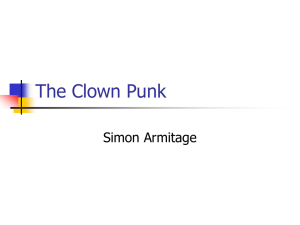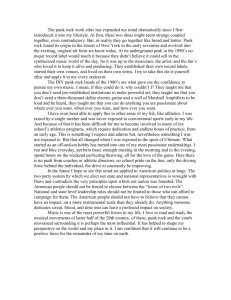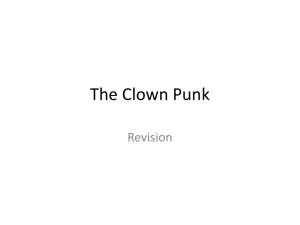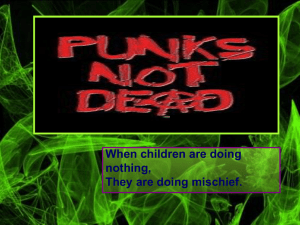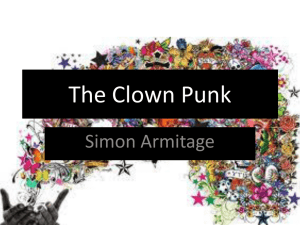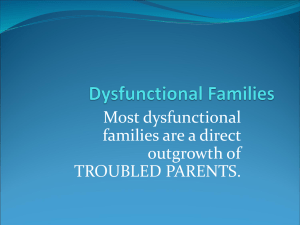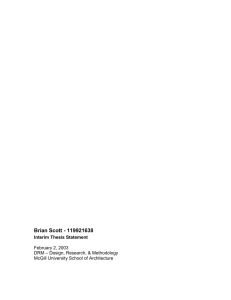The clown punk - WordPress.com
advertisement
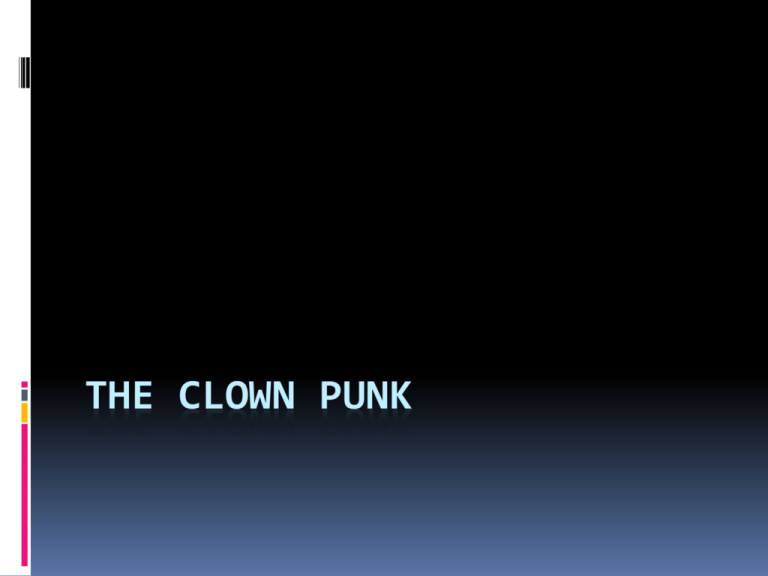
THE CLOWN PUNK Learning Objectives To present and develop my personal interpretation of the poems To identify and comment on the use of techniques To identify and comment of the use of language Watch the Clown Punk Video https://www.youtube.com/watch?v=t7OohxKyowQ Discussion How did some of the images make you feel? How do you feel about the “Clown Punk”? http://www.bbc.co.uk/learningzone/clips/sim on-armitage-on-his-poem-the-clownpunk/13452.html SUMMARY: The poem describes an encounter with the Clown Punk, a tattooed, slightly tragic character who presses his face against the windscreen of the narrator's car when it stops at traffic lights, frightening the children sitting in the back seat. Annotate your copy of the poem Identify examples of: Effective Language Use The IMAGERY created by the poem Techniques Areas of the poem that you PERSONALLY RESPOND to The way another reader might respond https://www.youtube.com/watch?v=25qqjAmFmKY Stanza by Stanza Analysis WHAT DO YOU NOTICE ABOUT THIS STANZA? These words make the poem seem chatty and light hearted Addressed to the reader Driving home through the shonky side of town, three times out of ten you’ll see the town clown, like a basket of washing that got up and walked, towing a dog on a rope. But Simile: describes untidy appearance of clown punk Tone: seems like a fun thing to see; the tone is happy. The word choice and easy rhythm create a positive tone Enjambment: unconventional for a sonnet – suggests we’re being told a story Stanza by Stanza Analysis Metaphor: his skin hasn’t actually been shot through but the ‘tattoo gun’ has damaged his skin beyond repair WHAT DO YOU NOTICE ABOUT THIS STANZA? These words create a negative or derisive tone which is added to by the condescending last line as though the narrator is sneering at the clown punk, thinking he’s pathetic don’t laugh: every pixel of that man’s skin is shot through with indelible ink; as he steps out at the traffic lights, think what he’ll look like in thirty years’ time – Tone: the tone has become serious because of the words ‘don’t laugh’ are usually used when we’re being told off Enjambment used to allow for extra detail about clown punk The narrator appears to be talking to his children ‘deflated’ and ‘shrunken’ show the clown punk’s age; it also reminds us of a clown’s balloon that has literally ‘sad tattoos’ deflated and shrunk – like the suggest the fun has gone from his life with clown punk is age pathetic Like the punk – the punk era the deflated face and shrunken scalp has ended still daubed with the sad tattoos of high punk. You kids in the back seat who wince and scream when he slathers his daft mush on the windscreen, Stanza by Stanza Analysis ‘daubed’ suggests the tattoos were badly done ‘daft mush’ suggests the narrator thinks the clown punk is silly (daft) and idiotic – this creates a derisive/negative tone WHAT DO YOU NOTICE ABOUT THIS STANZA? The last two lines suggest the clown punk is threatening – comment aimed at outsiders from society Stanza by Stanza Analysis WHAT DO YOU NOTICE ABOUT THIS STANZA? The narrator is suggesting to his children that they should remember the clown punk but then forget him – he is dismissing the clown punk; he has no respect for him because like all rebellions he feels this one won’t last which continues the negative and derisive tone remember the clown punk with his dyed brain, then picture windscreen wipers, and let it rain. The narrator tells the children to look and remember the clown punk but then to focus on the windscreen wipers in front – the rain could suggest the narrator is waiting for the rain to wash away the clown punk Metaphor: his brain isn’t literally dyed but the narrator seems to be suggesting that the punk era has ‘died’ (pun) and is out of date Comparison Give Each of the main characters in these two poems is someone who is not a part of conventional society: Armitage brings us face to face with them. Both characters make a scene by getting too close to an audience. The character in The Clown Punk doesn't get to speak to us, unlike the main character in Give: what difference does this make for the reader? Mid-Lesson Plenary How do you think each of the characters in the poem is feeling? The Clown Punk The Driver/Father The Children
